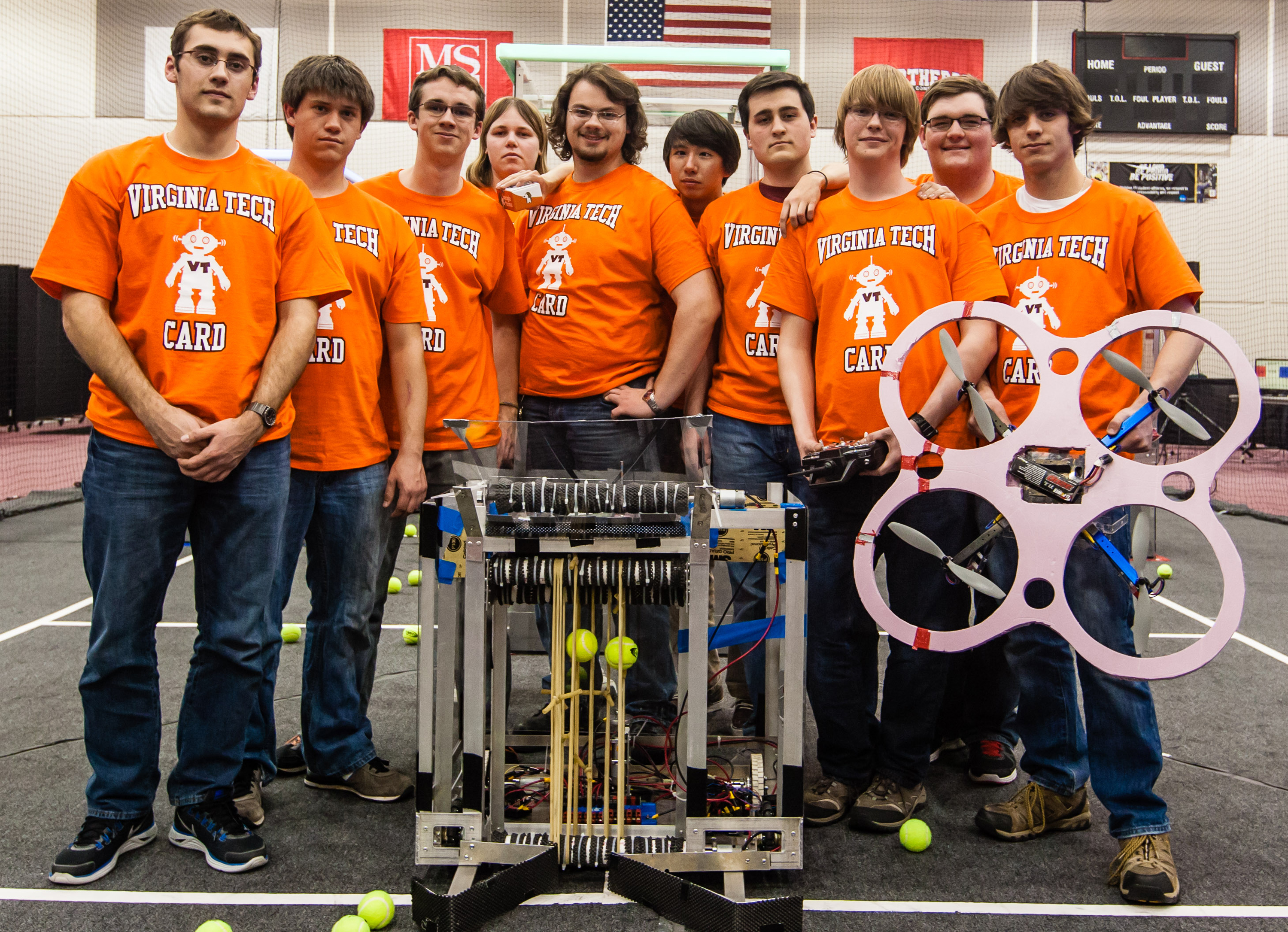Engineering students win aerial robotics competition

A team of Virginia Tech College of Engineering students won first place at the April 2013 Collegiate Aerial Robotics Exhibition held in Milwaukee, Wis., dominating a sporting-like competition where unmanned model-sized quad copters and ground-based robots collected and launched tennis balls at set targets.
Virginia Tech’s Collegiate Aerial Robotics Demonstration team fielded both a ground robot and an aerial robot, with each match requiring the robots to pick tennis balls off the ground and then fire them into five towers of varying height with holes cut into the sides and tops. The ground robot fired balls into the side openings, and the aerial robot scored by dropping balls into the towers from above.
“When they read off the final score, it felt like everything had come full circle, like all the 20-hour days and all the scrambling and scraping had been worth it,” said Josh Eddy of Arlington, team leader and a sophomore in aerospace engineering. “It felt like we had proven everything we set out to prove.”
The team won six of their nine matches with the robots, both designed and self-built by the students.
The 14-member Hokie team is comprised of sophomore engineers, several of whom earlier competed in the FIRST Robotics Competition, an international high-school design challenge. The Collegiate Aerial Robotics competition was launched in 2010, and this year hosted by Milwaukee School of Engineering.
Virginia Tech was the only team in competition to design robots that could successfully reload tennis balls during the match, said Eddy. The team also was the first to break 100 points in a match, going on to repeat that performance during three more matches and setting the high score for the day, he added.
The CARD team formed in November 2012, but without the intention of competing until 2014, after a year focused on prototyping and research. By late January, however, after a series of test runs, the team decided to enter the 2013 competition. Kevin Kochersberger, research associate professor with the Department of Mechanical Engineering and director of the Unmanned Systems Laboratory at Virginia Tech, served as the team’s faculty adviser.
“The best part was us starting as a new team and having the determination and resilience to build two robots in a short period of time and take them 700 miles away to compete and win,” said Kevin Hetzer of Mechanicsville, Va., and a sophomore in the mechanical engineering department.
Among the more difficult tasks was designing robots capable of reloading balls during a match, said Eddy. The plastic quadcopter, roughly two-feet in length diagonally, was designed to retrieve balls from the ground by students Hetzer; Brad Edelin, also of Mechanicsville, Va., and in mechanical engineering; Billy Greer of Manassas, Va., majoring in aerospace engineering; and Tim Kurtiak of Clinton, N.J., also in the aerospace department.
“Virginia Tech’s quadcopter was the only robot that could reload itself midgame, and was capable of picking up three tennis balls at a time,” said Eddy. During competition, Greer piloted the quadcopter by manual control. “Scoring required expert maneuvering with limited depth perception, so a system of hand signals was developed so that students on the sidelines could direct scoring efforts,” added Eddy.
The ground robot, featuring two funneling arms that swept the tennis balls into its “mouth,” was designed by Tyler Clark, also of Mechanicsville, Va., and in mechanical engineering. It also had the capability to eject balls to feed them to the quadcopter during a landing. Clark piloted the ground robot using an off-the-shelf video game controller.
Additional team members, all sophomores, included:
- Wesley Edge of Belmont, N.C., majoring in mining engineering;
- Wes Holland of Hardyville, Va., majoring in aerospace engineering;
- Jared Klein of Sterling, Va., majoring in chemical engineering;
- Brian Wright of Lynchburg, Va., majoring in computer science; and
- Bryan Yanchulis of King George, Va., majoring in electrical engineering.
The team is now deciding on its next competition, and exploring side projects to support future efforts, Eddy said.




